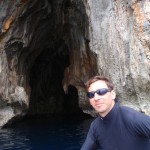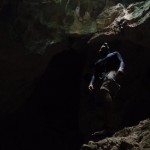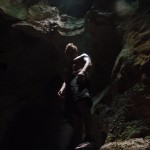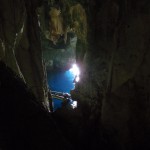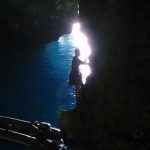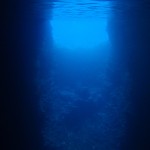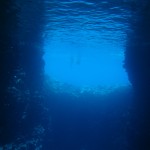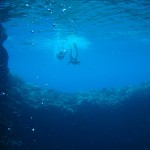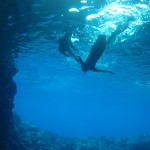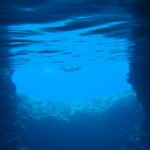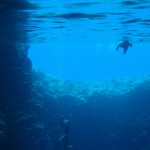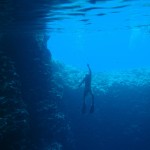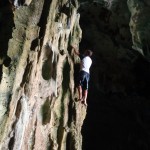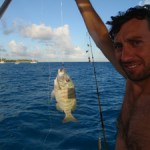Apr 18 2011
Lessons in Captainhood
This post backtracks a bit and talks about events that happened April 4th-8th.
It’s easy to write about fun things that happen, like in the next few posts to come about scuba diving a wreck or Justin imitating an Australian accent over the VHF to the coast guard. It’s harder, much harder for me, to write about screw-ups or flaws in my captaining. When Karen was writing about the trip, however, she was bravely honest and up front about when things weren’t going well and how she felt about it. So I’m trying to take some inspiration from her here.
Justin was at the helm as we approached a channel that would hopefully take us to a better anchorage. Though I would occasionally give him course corrections, Justin does a fine job of it and I was watching our course on our computer charting program below decks. Our original anchoring location seemed too exposed and the weather forecast said the wind would pick up. We had already seen two squalls blow by us earlier in the day where the wind had jumped from 10-15 knots to 30-35 in a matter of seconds. The water depth was 15 feet, which for Moreton Bay is quite good as half of it seems to be a minefield of sand bars. We were 100 yards away from a buoy that marked the channel. And then we abruptly slowed to a stop. We had run aground.
Since we had run aground in Fiji, I at least had an idea of what to do. In Fiji though, the water had been perfectly calm and it was a beautiful day. This time however, the situation was compounded by a nasty little wave chop and an impending storm on the horizon. I was desperate to get free before 30-35 knots of wind starting knocking us around and creating waves that would pound on us some more. As it was, each choppy wave would lift the boat slightly and set it down back on the sand with a small shudder. I dreaded feeling a much larger shudder if the approaching storm reached us.
I started racing around the boat, mimicking exactly what Matt had done when we ran aground previously. Dinghy into the water, outboard on, fuel attached, kedging anchor out. Justin quickly asked what he could do, and my mind raced as I tried to balance thinking about what I was currently doing, with the effort to explain to someone anxious to help but unfamiliar with the boat, unfamiliar with where items are, and unfamiliar with what we might need.
Just before speeding off in the dinghy to set the kedge anchor, I explained to Justin he needed to start cranking in the winch once I had dropped the anchor. Unlike in Fiji where we tried going forwards and sideways to break free, I had decided to pull us sideways and backwards. It seemed probable that it only got shallower moving forward. As he winched madly away, putting an prodigious effort into cranking the line in as fast as possible, I raced back to the boat and with snorkel mask on, dove down to try to see what was going on and pray there wasn’t any rocks around. With less than five feet of visibility, I couldn’t even see the bottom from the surface. Diving down to get closer to the keel, I thankfully saw there was only sand. I could also see the boat lifting on every wave and coming back down. It was unnerving.
Back on the boat, Justin and I swapped out every two minutes cranking in the anchor line on the winch. It was like sprinting with your arms, and in two minutes I would be out of breath and exhausted from cranking. As Justin kept cranking away at a now extremely taunt anchor line, I turned on the engine, hoping the water intake wouldn’t clog with sand. The low depth alarm on our depth sounder went off, freaking me out; I had never heard it sound before. I revved the engine in reverse, nothing happened. Justin and I swapped out; cranking the winch could only happen in the low gear now, straining will all one’s effort. Back at the helm I put the engine in reverse again; we slowly started inching backwards. We were free.
For a denouement, we struggled for 30 minutes to retrieve the kedge anchor, so stuck in the sand it had apparently become. it also started raining and the wind picked up. I was glad to be away from being grounded. Once free, Justin justifiably was ready to smile, laugh, and enjoy the fact that we and the boat had emerged unscathed. For myself, with adrenaline still coursing, I could hardly talk and wanted only to get to the anchorage we had previously passed on. An hour later, at anchor I slumped into the nav table with a beer. Mentally exhausted.
Justin kept saying afterwards, we gotta blog about it. And while I agreed, I knew part of me didn’t want to. I didn’t want to admit to a deficiency on my part. I didn’t want Matt to be worried about losing confidence in my ability to captain Syzygy.
A couple of days later we punched a hole through one of the polycarbonate windows that wrap around our dodger. Another error in captain-hood on my part, I wasn’t insistent enough to Justin to pull in the boom all the way to centerline before jibbing. The boom came over harder then it should. The boom is sheeted, moved in and out, by the main sheet line. The main sheet runs through blocks which are on a traveler. The traveler can be moved from side to side by the traveler line. The shock load from the boom coming over harder than it should caused the traveler line to break one of the pulleys it was attached to. The pulley snapped off violently into the polycarbonate dodger window and punched a hole through. Fixing this will probably be expensive and a huge ordeal. I was more upset with myself at this event than at running aground. At least when we ran aground I thought our location was fine and was telling Justin to stay on course. Here, I knew better. I knew the boom should be further to center before jibbing. I knew better and just didn’t insist to Justin that he needed put more effort into winching in the boom. He was tired of winching and asked if it was enough and if he could stop. I let him. I shouldn’t have and I knew it. I berated myself as captain and my lack of leadership.
A week later, I e-mailed Matt, almost sheepishly, intro-ing with the line, ‘well I suppose I should tell you…’ I felt like a student handing in a final exam, embarrassingly mumbling to his favorite professor that he hadn’t studied well enough and had done poorly.
I’m hoping I can do better in the future.
